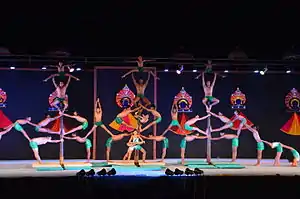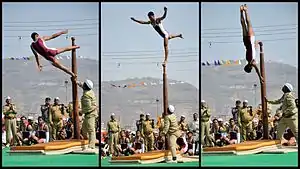Mallakhamba
Mallakhamb is a traditional sport, originating from the Indian subcontinent, in which a gymnast performs aerial yoga or gymnastic postures and wrestling grips in concert with a vertical stationary or hanging wooden pole, cane, or rope. The word Mallakhamb also refers to the pole used in the sport.[1] The pole is usually made from sheesham (Indian rosewood) polished with castor oil.[2] Three popular versions of Mallakhamb are practiced using a sheesham pole, cane, or rope.[3]

The name Mallakhamb derives from the terms malla, meaning wrestler, and khamb, which means a pole. Literally meaning "wrestling pole", the term refers to a traditional training implement used by wrestlers.[4]
On April 9, 2013, the Indian state of Madhya Pradesh declared Mallakhamba the state sport. As of 2017, more than 20 other states in India have followed suit.[5]
History
Chandraketugarh pottery (Dated 2nd century BCE - 1st century CE) with narrative figures carved on them show a couple exhibiting gymnastics by hanging on a pole like structure in the shape of a T which is held by another person. In 7th century CE, Chinese Buddhist pilgrim Xuanzhang provides evidence of pole climbing of the pillar cult which he witnessed at Allahabad, he states that hindu ascetics climbed the top of a pole situated at Allahabad clinging onto it with one hand and one foot while other hand and foot stretched out in the air and watched sunset with their heads turned right as it set which indicates a solar rite.[6] The earliest literary known mention of Mallakhamb is in the 1135 CE Sanskrit classic Manasollasa, written by Someshvara III. A Rajput painting from 1610 CE shows athletes performing various acrobatics, including pole climbing while dancing to Raga Desahka.[7] A Mughal painting from 1670 depicts wrestlers or athletes practicing club swinging, weightlifting, and pole climbing similar to Mallakhamb.[8] The art form since remained dormant until it was given a new lease on life by Balambhatta Dada Deodhar, the teacher of Peshwa Baji Rao II. During the first half of the 19th century, Lakshmibai, the Rani of Jhansi learned Mallakhamb with her childhood friends Nana Saheb and Tantia Tope.[9]
Mallakhamb as a Competitive Sport was first time Developed by the Mallakhamb Federation of India in January 1981 and the rules and regulations were also introduced for the first time in the First National Championships held from 28 to 29 January 1981.

Competitive Mallakhamb at the national level first made its appearance in 1958 at the National Gymnastics Championships (NGCs) held at the Pahadganj Stadium, Delhi, India. The Gymnastics Federation of India (GFI) proposed to recognize the game and include it in subsequent NGCs. The first National Mallakhamb Championships were held in 1962 at Gwalior, Madhya Pradesh, as part of the NGCs. Around 1968, the game was introduced in the All-India Inter-University Gymnastics Championships. The National Mallakhamb Championships were organized annually by the GFI until 1976. In 1977, these Mallakhamb Championships were removed from the GFI, and no major championship games were held until 1980.
Bamshankar Joshi and other Mallakhamb enthusiasts at Ujjain, Madhya Pradesh, founded an All-India Level Organization named the Mallakhamb Federation of India. The first All-India National Mallakhamb Championships were organized by the New Sports Association from January 28 to 29, 1981, at Ujjain, Madhya Pradesh. The event brought in representatives from all over India; they participated in these championships and this organisation has been registered in 07 June 1984 as Mallakhamb Federation wide Registration No.13752. The National Mallakhamb Championships have since been organized by different state associations affiliated to this Federation.
Competitively, there are several versions but three variations of Mallakhamb sport are in practice since 1937:
- Pole Mallakhamb
- Hanging Mallakhamb
- Rope Mallakhamb
All are practiced by both men and women, though Pole Mallakhamb is more commonly practiced by men and boys, and Rope Mallakhamb by women and girls.[10] All Mallakhamb competitions are organized under the rules made by the Mallakhamb Federation of India, and 28 states are affiliated to the Federation.
Variations and specifications
Pole Mallakhamb
In this variation, a vertical wooden pole made of teak wood or sheesham is fixed to the ground. The pole is smeared with castor oil, which helps to minimize excessive friction. Participants perform various acrobatic feats and poses while hanging on the pole. Wrestlers mount, dismount, and utilize the pole for various complex calisthenics designed to develop their grip, stamina, and strength in the arms, legs, and upper body.
There are a number of pillars, although the most common is a free-standing upright pole, some eight to ten inches in diameter, planted into the ground. The pole used in competitions is a straight pole made of teak or sheesham wood, standing 2.6 metres (8.5 ft) in height with a circumference of 55 centimetres (22 in) at the base. It gradually tapers to a circumference of 35 centimetres (14 in) at the top.
The specifications of Pole Mallakhamb are as follows:
| Range | Height (Senior Group) | Height (Sub-Junior Group) |
|---|---|---|
| Above the ground | 2600 to 2800 | 2400 to 2600 |
| Under the ground | 800 to 900 | 700 to 800 |
| Neck | 180 to 200 | 180 to 200 |
| Top | 70 | 60 |
| Total length | 3400 to 3700 | 3100 to 3400 |
| Circumference | ||
| Bottom | 530 to 550 | 480 to 500 |
| Below the neck | 300 to 350 | 300 to 350 |
| Neck | 180 to 200 | 180 to 200 |
| Top | 350 | 300 |
| Note: All dimensions are in millimeters (mm) | ||
Hanging Mallakhamb
This type of Mallakhamb is similar to Pole Mallakhamb, but it uses a wooden pole shorter than the standard pole in Pole Mallakhamb. The pole is hung with hooks and a chain, leaving a gap between the ground and the bottom of the Mallakhamb.
The specifications of Hanging Mallakhamb are as follows:
| Range | Height |
|---|---|
| 1700 to 1900 | |
| Neck height | 180 to 200 |
| Top height | 70 |
| Distance between bottom and ground | 650 to 700 |
| Height of the structure | 4600 to 4800 |
| Circumference | |
| Bottom | 4500 to 5000 |
| Neck | 180 to 200 |
| Below the neck | 250 to 300 |
| Note: All dimensions are in millimeters (mm) | |
Rope Mallakhamb
In this variation, the participant performs exercises while hanging on a rope suspended from a support at the top.[11] The rope is typically 5.5 metres (18 ft) long, and approximately 1 to 2 centimetres (0.39 to 0.79 in) in diameter. The rope is caught by the performer in the gap between the big toe and the second toe, along with one or both hands. After climbing upwards on the rope, the performer ties the rope around the body through a sequence of steps. The performer then reaches various positions called Udi ("to fly"), some of which are imitations of standard asana.
Rope Mallakhamb was historically performed on a cane, but due to the lack of good cane, a cotton rope is used. Performers are expected to perform various exercises without knotting the rope in any way.
The specifications of Rope Mallakhamb are as follows:
| Dimension | Measurement (Senior Group) | Measurement (Sub-Junior Group) |
|---|---|---|
| Length | 6000 to 6500 | 6000 to 6500 |
| Thickness | 18 to 20 | 12 to 13 |
| Height of the structure | 5800 to 6000 | 5800 to 6000 |
| Note: All dimensions are in millimeters (mm) | ||
Official International Organizations
Official Indian Mallakhamb Sport National Organization
- Mallakhamb Federation which is widely known as Mallakhamb Federation of India MFI before it's registered in 07 June 1984 with Registration No.13752 in Ujjain, M.P.
- ^Mallakhamb Federation^ is affiliated with Vishwa Mallakhamb Federation, Mallakhamb Confederation of World MCW, Asian Mallakhamb Federation AMF, South Asian Mallakhamb Federation SAMF.
References
- Games, sports and cultures. Dyck, Noel. Oxford: Berg. 2000. p. 96. ISBN 1-85973-312-3. OCLC 44485325.CS1 maint: others (link)
- Sport in the USSR. - Issues 1-12; Issues 286-297, pp.9
- Sport across Asia: politics, cultures, and identities. Bromber, Katrin., Krawietz, Birgit., Maguire, Joseph. New York: Routledge. 2013. p. 137. ISBN 978-0-415-88438-9. OCLC 800447515.CS1 maint: others (link)
- "Mallakhamb – History, Indian Gymnastic Pole, Information In English". Mumbai, India. September 12, 2018.
- "Mallakamb: The art of aerial yoga". Hindustan Times. June 11, 2017. Archived from the original on November 14, 2018. Retrieved November 24, 2019.
- Irwin, John (1983). "The Ancient Pillar-Cult at Prayāga (Allahabad): Its Pre-Aśokan Origins". Journal of the Royal Asiatic Society of Great Britain and Ireland (2): 253–280. ISSN 0035-869X.
- "painting". British Museum. Archived from the original on February 15, 2019. Retrieved February 15, 2019.
- Ashmolean Museum, University of Oxford. "Ashmolean − Eastern Art Online, Yousef Jameel Centre for Islamic and Asian Art". jameelcentre.ashmolean.org. Archived from the original on February 4, 2019. Retrieved February 4, 2019.
- Agarwal, Deepa (2009). Rani Lakshmibai: the valiant queen of Jhansi. New Delhi: Puffin. ISBN 978-0-14-333084-4. OCLC 666466167.
- Holland, Samantha. (2010). Pole dancing, empowerment and embodiment. Houndmills, Balsingstoke, Hampshire: Palgrave Macmillan. p. 62. ISBN 978-0-230-29043-3. OCLC 688185171.
- "Mallakhamb: Ancient Indian sport". MSN News. India. December 5, 2012. Archived from the original on January 16, 2013.
- https://indianexpress.com/photos/india-news/india-hosts-first-ever-world-mallakhamb-championship-in-mumbai-5590757/
- https://www.news18.com/news/sports/india-win-team-event-at-mallakhamb-world-championship-2039549.html
Further reading
- Mallakhamb: An Investigation Into the Indian Physical Practice of Rope and Pole Mallakhamb by Jon Burtt, Edith Cowan University, 2010.[1]
External links
| Wikimedia Commons has media related to Malkhamb. |
- Mallakhamb India website
- "IndiaPress.org". Listing of traditional games and sports of India. Retrieved April 1, 2007.
- "mallkhambindia.com". Mallakhamb: The Authentic Indian Sport. Retrieved April 1, 2007.
- "aquafishsilver.com". "MALLAKHAMB" – A Great Traditional Ancient Art of Indian Physical Culture. Archived from the original on July 2, 2007. Retrieved April 1, 2007.
- Mujumdar, D.C., ed. (1950). The Encyclopedia of Indian Physical Culture. Baroda: Sree Ram Vijaya Printing Press.CS1 maint: extra text: authors list (link)
- https://web.archive.org/web/20101210030821/http://library.thinkquest.org/11372/data/mallakhamb.htm
- https://www.news18.com/news/sports/india-win-team-event-at-mallakhamb-world-championship-2039549.html
- https://indianexpress.com/photos/india-news/india-hosts-first-ever-world-mallakhamb-championship-in-mumbai-5590757/
- Burtt, Jon (2010). Mallakhamb: An Investigation Into the Indian Physical Practice of Rope and Pole Mallakhamb. International Journal of the Arts in Society. Edith Cowan University.